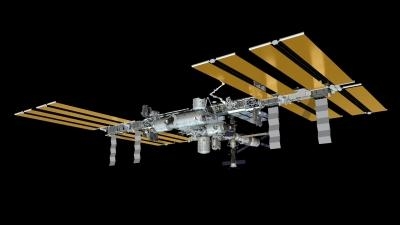Thu, May 01, 2014
Soliciting Ideas For Ways To Create Greater Access To The Orbiting Outpost
As part of NASA's continuing effort to open low-Earth orbit to commercial space opportunities, the agency is seeking feedback on ways it can help create greater access to and use of the International Space Station for research and commercial activities.

Through a Request for Information (RFI), NASA is soliciting ideas from companies interested in using the space station and the low-Earth orbit environment in innovative ways that will develop a strong commercial market and assist the agency in achieving its exploration goals.
The expanding U.S. commercial space industry has been able to create self-sustaining economic opportunities in low-Earth orbit, enabled by NASA's commitment to reducing and removing barriers to a commercially-driven U.S. market. This has allowed the agency to sharpen its focus on deep space exploration.
NASA announced Jan. 9 that it intends to extend the country's commitment to the International Space Station to at least 2024. This extension provides opportunities, some already under implementation, to broaden private market access to the unique microgravity environment aboard the space station.
"Now is an exciting time for space research and developing exploration capabilities," said William Gerstenmaier, associate administrator for Human Exploration and Operations at NASA Headquarters in Washington. "After 10 years of continuous habitation in low-Earth orbit, we know microgravity provides data unattainable on Earth. We are already seeing benefits in pharmaceuticals, medical robotics and materials sciences. This RFI will help identify how to open this one-of-a-kind orbital laboratory to the private sector in better and more practical ways -- ultimately, helping to pave the way for private microgravity research facilities of the future."
Responses to the RFI should detail ideas that could further efforts to:
- create a private system in low-Earth orbit
- develop crew transportation to enable commercial activities aboard the station beyond NASA requirements,
- break down access-, programmatic- and business-related barriers to realizing these objectives,
- address NASA capabilities or expertise that would help facilitate transitioning to a more commercially-driven presence, or
- identify capabilities and resources NASA could purchase from the commercial sector to allow NASA research activities to continue beyond the life of the space station.
Responses also may provide recommendations on how private research, and other activities, could be performed on the space station to foster future commercial value or demand for access to low-Earth orbit and further NASA's exploration mission.
Responses should be no more than 20 pages and are due by June 30.
(Images from file)
More News
“Our company is moving in the right direction as we start to see improved operational performance across our businesses from our ongoing focus on safety and quality. We conti>[...]
Aero Linx: International Committee for Airspace Standards and Calibration (ICASC) The International Committee for Airspace Standards and Calibration (ICASC) was created following t>[...]
From 2013 (YouTube Edition): One Of Aviation's Most Positive Efforts... The VAC!!! In all the doddering, misleading, anti-aviation blather we've had to deal with over the last few >[...]
Also: CiES Documents, Hypersonic Tech, SKYTRAC Health Monitoring, Skyryse Archer Aviation announced a blueprint for an eVTOL network in New York City that would connect travelers b>[...]
Also: Sun Country CEO to Spirit, Indian AF Rafale Jets, Archer-United, Avflight Grows Federal prosecutors recently filed a lawsuit against an uncertified charter flight company and>[...]
 Aero-News: Quote of the Day (04.27.25)
Aero-News: Quote of the Day (04.27.25) ANN's Daily Aero-Linx (04.27.25)
ANN's Daily Aero-Linx (04.27.25) Classic Aero-TV: Veteran's Airlift Command -- Serving Those Who Served
Classic Aero-TV: Veteran's Airlift Command -- Serving Those Who Served Airborne-NextGen 04.22.25: NYC eVTOL Network, ForgeStar-1, Drone Safety Day
Airborne-NextGen 04.22.25: NYC eVTOL Network, ForgeStar-1, Drone Safety Day Airborne 04.21.25: Charter Bust, VeriJet Woes, Visual Approach Risks
Airborne 04.21.25: Charter Bust, VeriJet Woes, Visual Approach Risks



